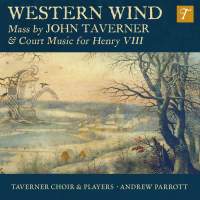Texte paru dans: / Appeared in: |
|
|
Outil de traduction ~ (Très approximatif) |
|
|
Reviewer: Barry
Brenesal “Who better to represent the richness of early Tudor music-making than John Taverner and his almost exact contemporary, King Henry VIII?” asks Andrew Parrott, leading off his liner notes. It’s an interesting question, but begs another: Can a single album sustain a mix of sacred music by Taverner, interspersed with light-hearted secular music of the period, at least some of which, Cornysh’s works and those of the monarch himself, would likely have been heard at Henry’s court? It wouldn’t be as much of an issue if the sacred and secular aspects of this album were kept in separate sections, or linked through some means. This in fact happens only once: the folk theme as heard in the three Masses of Taverner, Tye, and Sheppard is played on solo recorder before the Kyrie chant. (Not set, because, as you know, the English custom of the period precluded any polyphonic Kyrie setting.) But then, admittedly to my listening astonishment, the disc segued into the well-known anonymous piece My lady Careys dompe; followed by the Credo; followed by a loud ensemble arrangement (presumably Parrott’s) of Henry Tudor’s If love now reynyd. Then comes the chant Sursum corda followed by Taverner’s Sanctus, followed by a harp rendition of My lady Wynkfylds rownde. It’s decidedly odd, made the more so in that Taverner’s Mass is, in effect, a series 36 variations on Western Wynde, nine per movement, without any other content between them. If ever there was a case that could be made for performing a pre-Baroque Mass without musical interpolations, it’s this one. But if we must have interpolations, then some of Taverner’s shorter sacred works would seem a better stylistic and expressive fit. That noted, there’s no reason to complain about the performances. Parrott’s vocalists are excellent, and he produces a precise, clear distinction between parts while maintaining perfect balance among them. There’s no list of singers per part, though at a guess it’s two or three. (Venue and engineering can play tricks in such matters.) His instrumentalists display a similar excellence of technique. The energy, enthusiasm, and variation in dynamics in the Credo alone make this one of the most compelling versions of the Mass on records. The choice of Parrott’s other filler by Taverner later in the album is good, though most likely to appeal to the listener who has never encountered the composer’s music before, given its prominence on disc. We get Audivi vocem de caelo, with its ebullient melisma at “Ecce sponsus venit,” and Dum transisset sabbatum, limited here to a divided male choir for fine, rich effect. There’s also a harpsichord transcription of the famous In nomine passage from the Benedictus passage of Taverner’s Missa Gloria tibi Trinitas. The works by Henry VIII also deserve comment. David Fallows in his The Henry VIII Book considers many of them “shallow efforts.” Both David Greer in Grove I and Allan Atlas in his Renaissance Music make this point more emphatically, stating that many of his vocal compositions are simply arrangements of pre-existing music, sometimes with a new, awkwardly added extra line. Atlas goes so far as to write, “That Henry dabbled at composition should not surprise us. After all, both Charles the Bold and Leo X did the same. And like them, Henry was every bit the amateur.” I can’t speak to If love now reynyd, but his version of Taunder naken (Tandernaken) in three parts is of far less interest than any other of the many versions I’ve heard to date. If these are the best Henry had to offer, it is perhaps a good thing he concentrated much of his time and his enormous wealth instead on collecting wives, guns, instruments, precious stones, and tapestries. Finally, note that Parrott ends the disc with the original folk tune Westron Wynde, which bears some resemblance to the version used in the three Masses, then attempts his own reconstruction figuring the Mass theme’s version as a countermelody to be played against the original. I’m not convinced, but it is interesting, a point that could be made about everything heard here. Texts
and translations are offered when required. In the Mass, the Latin incipits
are supplied for all movements and each section of a movement. This release
is an unusual experiment, thoroughly mixing secular, far from elevated music
that could well have been heard at court, and some of the most sweetly
inspired and conceived sacred music ever written. I’m still not sure it
works, but I am absolutely certain the performances are worth more than a
just a single hearing. | |
|
Support us financially by purchasing this disc from eiher one of these
suppliers. |
|
|
|
|
|
Cliquez l'un ou l'autre
bouton pour découvrir bien d'autres critiques de CD |
|




